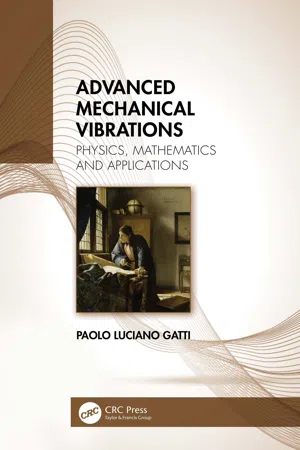
Advanced Mechanical Vibrations
Physics, Mathematics and Applications
Paolo Luciano Gatti
- 320 pages
- English
- ePUB (mobile friendly)
- Available on iOS & Android
Advanced Mechanical Vibrations
Physics, Mathematics and Applications
Paolo Luciano Gatti
About This Book
Advanced Mechanical Vibrations: Physics, Mathematics and Applications provides a concise and solid exposition of the fundamental concepts and ideas that pervade many specialised disciplines where linear engineering vibrations are involved. Covering the main key aspects of the subject – from the formulation of the equations of motion by means of analytical techniques to the response of discrete and continuous systems subjected to deterministic and random excitation – the text is ideal for intermediate to advanced students of engineering, physics and mathematics. In addition, professionals working in – or simply interested in – the field of mechanical and structural vibrations will find the content helpful, with an approach to the subject matter that places emphasis on the strict, inextricable and sometimes subtle interrelations between physics and mathematics, on the one hand, and theory and applications, on the other hand. It includes a number of worked examples in each chapter, two detailed mathematical appendixes and an extensive list of references.
Frequently asked questions
Information
Chapter 1
A few preliminary fundamentals
1.1 Introduction
1.2 Modelling vibrations and vibrating systems
Table of contents
- Cover
- Half Title
- Title Page
- Copyright Page
- Dedication
- Table of Contents
- Preface
- Acknowledgements
- Frequently used acronyms
- 1 A few preliminary fundamentals
- 2 Formulating the equations of motion
- 3 Finite DOFs systems: Free vibration
- 4 Finite-DOFs systems: Response to external excitation
- 5 Vibrations of continuous systems
- 6 Random vibrations
- Appendix A: On matrices and linear spaces
- Appendix B: Fourier series, Fourier and Laplace transforms
- References and further reading
- Index